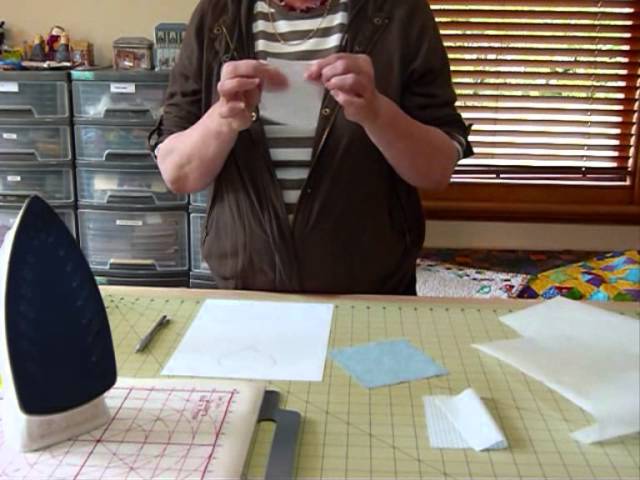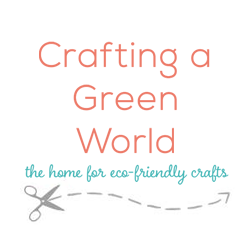How safe is fusible webbing to use?
In Autumn’s post The Eco-Crafters List of Demands, she asked crafters for their thoughts on how to make commerically sold craft supplies more friendly to the planet and the people who live on it. One question she asked particularly stood out to me:
What items have such scary warning labels that you are asking yourself, “Is this project worth giving myself brain damage over?”

Image source
One of the products that immediately came to my mind was fusible web. Fusible web is a synthetic fiber that melts when you heat it. Brand names for these products include Steam-A-Seam, Stitch Witchery, and others. If you’re not familiar with it, think of it as thin sheets of fabric infused with glue. If you need two pieces of fabric to stick together, or you’re working with a fabric that needs a little extra support to either stand up or hold still, then you may end up using your iron to attach some fusible web to your project. You’ll often find fusible web in applique, t-shirt quilts, and used as interfacing in clothing.
But honestly, I’ve never tried to research it and figure out whether it’s a product I can feel good about using. Can it hurt me by touching it? Is it safe to heat glue with an iron and breathe at the same time? I have educated myself about food, personal care products, and clothing, and made (not enough) changes in my life based on what I found. So far, though, I haven’t given my crafting products much scrutiny beyond my varied attempts to use my local thrift store as a craft supply shop.
So just how easy is it to find out whether a product is safe and eco-friendly? Using fusible web as my test case, I set out to get some answers. Some of what I found may be old hat to y’all, but I learned quite a lot.
In this post, I cover safety issues; watch for Part 2 about environmental issues here.
My first stop on my research odyssey was the packaging of the product in question. I have some Steam-A-Seam and Lite Steam-A-Seam 2 in my studio upstairs, so I went to take a look. On the back, I found the following statement:
Steam-A-Seam poses no chronic or adverse health effects when used as intended and conforms to LHAMA Regulations, ASTM D4236-94. Testing is in accordance with guidelines specified by the Consumer Product Safety Commission in 16 CFR 1500.135.
Huh? Time for a little Google searching.
The Art and Creative Materials Institute, a non-profit association of manufacturers of art and craft supplies, explains LHAMA thusly:
Under the U. S. Labeling of Hazardous Art Materials Act (LHAMA), all art materials sold in the U. S. must be evaluated by a qualified toxicologist and labeled, if necessary, for chronic toxicity according to the chronic hazard labeling standard, ASTM D 4236. LHAMA, which went into effect November 18, 1990, amends the Federal Hazardous Substances Act (FHSA) to require art and craft materials manufacturers to evaluate their products for their ability to cause chronic illness (such as cancer) and to place labels on those products that provide health and cautionary information and safe use instructions. FHSA already required manufacturers to evaluate and label for acute toxicity.
The labeling standard ASTM D4236-94 was developed as a voluntary standard by the private standards developing company ASTM previous to the passage of LHAMA. The final federal rule on labeling was issued in 1992, and it codified the ASTM standard as a mandatory requirement. According to Michael McCann of the Center for Safety in the Arts, the way the federal rule defined hazards as follows (emphasis mine):
A substance is a chronic hazard if it is a known or probable human carcinogen, and has a cancer risk of one in a million or more, or is a known or probable neurotoxic or reproductive or developmental toxicant, and if exposure is above a certain defined level (Allowable Daily Intake). This level is based on levels known to affect humans or animals, with the incorporation of safety factors. The definition of a known human carcinogen, for example, is for which there is “sufficient evidence” of carcinogenicity in humans, and a probable human carcinogen is one in which there is “limited evidence” of carcinogenicity in humans or “sufficient evidence” in animals (16 CFR 1500.135). Similar definitions apply to neurotoxins and developmental or reproductive toxicants.
So if my packages of fusible web are correctly labeled, I shouldn’t have to worry about getting poisoned today (acute toxicity) or that pesky brain damage that Autumn was mentioning (chronic hazard).
The history of LHAMA that I’ve read indicates that it was passed into law with the support of arts organizations in cooperation with manufacturers who wanted a single federal law to preempt individual state laws that were being passed. So my guess is that LHAMA is better than nothing, but not as aggressive as it could be. The recent scuffle about BPA in baby bottles (and the FDA’s decision to re-evaluate their previous position) has shown that the feds aren’t always the leaders on these issues, but at least there are some requirements for testing and labeling these products.
Autumn asked me how often the standards themselves are updated and whether products are re-evaluated as additional information is discovered. From what I can tell from the ASTM website, the standards seem to have been updated in 2001 and 2005… but there’s not exactly a FAQ on the site that explains how to interpret the search results for any given standards. The general public probably doesn’t wander by too often trying to figure this stuff out.
Leslie also pointed out to me that the testing is done on single products, not products in combination, “like mixing prescription drugs.” At least when you’re using prescription drugs, your doctor and pharmacist are supposed to check for interactions. I don’t think your local craft store personnel are qualified to provide that kind of technical support.
Resources for Arts and Crafts Safety Information
There are a number of online resources for checking on the safety risks of various products:
- Health and Safety in the Arts: A Searchable Database of Health and Safety Information for Artists by the City of Tucson’s Environmental Management Division
- Art and Creative Materials Institute’s database of safe arts and crafts supplies (which I found out about originally from our sister blog Eco Child’s Play), but keep in mind that ACMI is an association of manufacturers and not a disinterested party
Here are a few other resources for your perusal:
- Art and Craft Safety Guide (PDF), Publication 5015, Consumer Product Safety Commission, focusing on children’s arts and crafts
- Keeping the Artist Safe: Hazards of Arts and Crafts Materials, a directory of information created by the Specialized Information Services of the National Library of Medicine at the National Institutes of Health
- Resources: Art – Supplies at Greening Schools, a joint effort of the Illinois Environmental Protection Agency (IL EPA) and the Illinois Waste Management and Research Center (WMRC)
Crafting a Green World

PROFILE
Crafting a Green World is the home for green crafts.
We know that buying handmade or making things ourselves is more eco-friendly than shopping at big box stores, but how can we make sure that our green crafts are truly benefiting the planet? That’s what Crafting a Green World is all about!
From sustainable fabrics and ideas for creative reuse to eco-friendly art supplies and tutorials, we want to help you dive into green crafts by making them fun and accesible. We feature everything from tutorials and supplies to green crafters and book reviews. Crafting a Green World (CAGW) is your number one resource for organic, natural, and recycled crafty projects, products, media, and businesses.
Main Research Source
- Researching plastics is a minefield. If manufacturers were obliged to disclose the composition of their product, it would make it a lot more straight forward and we’d be more able to make an informed decision more easily.
- What Skye found was not 100% reassuring, but al least there are at least some safety regulations in place for arts and craft supplies, and fusible web does meet those standards.
- In terms of eco-minded decision making and given the lack of applied studies, we have to apply common sense and judgement; Don’t carry out projects with an over reliance of fusible webbing, if you do use it -use sparingly, look out for alternatives- both in available products and alternative techniques. If you find a good alternative, share it with others.

